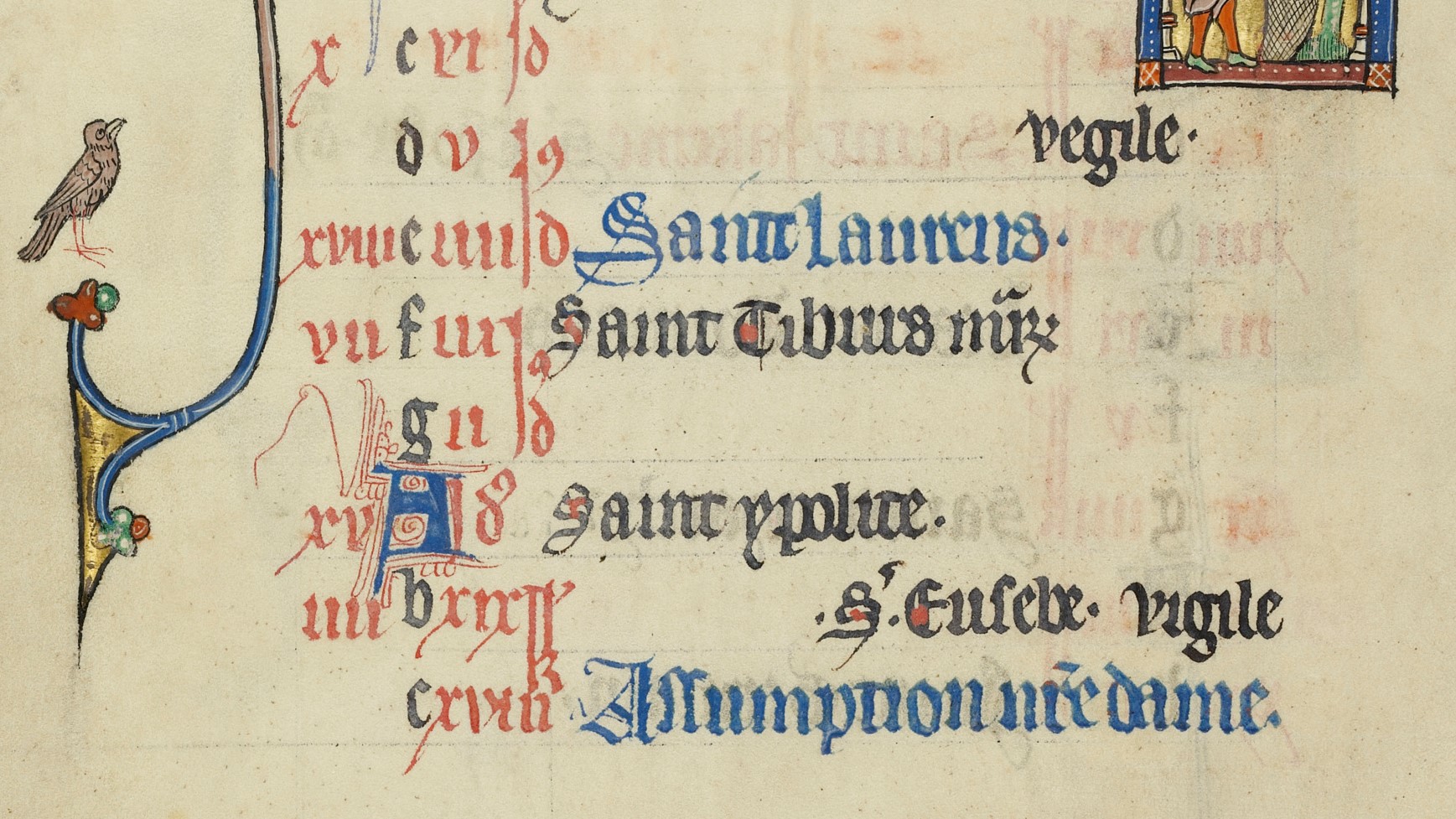

Deacon-structing solemnities, feasts, and memorials
Deacon Pedro
Monday, January 25, 2021

Detail of a medieval calendar showing feast days in August. The more important feast days (Saint Lawrence and the Assumption) are written in blue, and their vigils are also marked. The J. Paul Getty Museum, Los Angeles, Ms. Ludwig IX 3, fol. 9v. Digital image courtesy of the Getty's Open Content Program.
I remember being in Assisi in 2001 on the Feast of All Saints. The organizer of our trip had arranged for our group to have lunch with the Franciscan friars. It was a lovely meal. I remember thinking that there wasn’t much poverty if they always ate like this: several courses, meat, lots of wine – even dessert and good Italian coffee!
When I commented on it to one of my travel companions, he clarified that the friars don’t usually eat meat. In fact, normally their meals are very humble. But November 1st was a solemnity, and so they marked it by having a feast!
Had you asked me 10 years ago what a solemnity was, I'm not sure I would have been able to respond correctly. I knew that in the Church we had “feasts” – I also had a sense of what some of those feasts were, but I would not have known which were solemnities or what the difference was.
You are probably the same. You probably have a sense of the liturgical seasons: Advent, Christmas, Lent, Easter, and Ordinary Time. These seasons help us identify the highs and lows of our faith journey (read more about this in Deacon-structing Ordinary Time). Those seasons are marked by special days that the Church calls feasts to help us observe what’s important in our Faith.
Feast days began when early Christians would commemorate the day someone was martyred as a way to remember them and to recognize their holiness. This is how we have such an accurate record of when all the saints died: because those around them recognized their holiness before they died and so made a point to remember their deaths. Eventually non-martyrs were also remembered as they were venerated as saints. Slowly, the Calendar of Saints began to grow.
Some feast days are referred to as feasts, but there are also solemnities and memorials.
Solemnities
The most important of these are solemnities, from the Latin sollemnitas, which means festival or celebration. It is a day that is solemn, sacred, and dedicated to religious observances.
We must first remember that every Sunday is a solemnity. Outside of Sundays, we have other solemnities, like Trinity Sunday, Corpus Christi, Immaculate Conception, and All Saints, to mention a few.
Most solemnities are Christ-centred: for example, Christmas, Epiphany, Ascension, Pentecost, Sacred Heart, and Christ the King. Others are Marian: Annunciation, Assumption, Immaculate Conception, and Mary, Mother of God. Others commemorate saints, like St. Joseph, Nativity of John the Baptist, and Saints Peter and Paul. According to the General Roman Calendar, there are a total of 17 solemnities that apply to the Universal Church.
There are also what are referred to as “proper solemnities”. These are solemnities which are not universal but may be observed in particular places. For example, St. Patrick’s Day (March 17) is a solemnity in Ireland, Our Lady of Czestochowa is one in Poland, and the memorials of St. Rose of Lima and St. Martin de Porres are solemnities in Peru. Also, every religious congregation will celebrate the feast or memorial of their founder as a solemnity.
When you go to Mass on a day that is not a Sunday, you will know it is a solemnity because there will be a Gloria, a second reading, and the Creed (parts which are omitted during a regular daily Mass).
The differences between solemnities, feasts, and memorials become very clear once you begin to pray the Liturgy of the Hours. If you do, you know that each solemnity begins on the evening before (which happens every Saturday night with what is called Sunday Evening Prayer 1). Some solemnities (like Easter and Christmas) will have their own Vigil Mass that is celebrated on the eve of the feast (this is how we get “all hallows' eve” – which is the eve of All Saints Day. All Saints day begins on the prior evening).
Feasts
Of second importance are feasts. These days do not have an “Evening Prayer 1” on the evening prior. The only exception would be when one of these feasts occurs on a Sunday – which doesn’t happen often because Sunday, being a solemnity, will always “trump” a feast day. Examples of feasts are Baptism of the Lord, Presentation of the Lord, Transfiguration (Aug 6), all the days commemorating the Apostles and the evangelists, the Conversion of St. Paul (Jan 25), the Visitation (May 31), the Birth of Mary (Sept 8), the feast of the Archangels (Sep 29), and the dedication of St. John Lateran (Nov 8).
The only non-apostle or evangelist saints who have a feast day are St. Lawrence (Aug 10) and Mary Magdalene (July 22).
Memorials
Lastly, we have memorials, which mostly commemorate saints but may also be Marian or Christ-centred, as in the memorial of the Holy Name of Jesus or the memorial of the Immaculate Heart of Mary. If you were to attend Mass on a feast day or a memorial, the presider may choose to use the readings and prayers which are specific to the day. A memorial, for example, will always have at least an opening prayer (collect).
You may not have a tradition of feasting with the Church. Unless a solemnity or feast is celebrated locally or on a Sunday, you may never have had an experience like the one I had in Assisi. Perhaps this is something you can begin doing in your homes and with your families. What makes Sundays different in your home? Would you do a novena at home with your family? What separates an ordinary Monday from the feast of your own patron saint? Which holy days would you commemorate as a family?
I encourage you all to begin doing little (or big) things to celebrate these days that the Church has marked for us as a reminder that we are part of God’s life.
To get you going, here are some feasts and solemnities coming up:
 Every week, Deacon Pedro takes a particular topic apart, not so much to explore or explain the subject to its fullness, but rather to provide insights that will deepen our understanding of the subject. And don’t worry, at the end of the day he always puts the pieces back together. There are no limits to deaconstructing: Write to him and ask any questions about the faith or Church teaching: [email protected]. Follow him on Facebook, Twitter and Instagram.
Every week, Deacon Pedro takes a particular topic apart, not so much to explore or explain the subject to its fullness, but rather to provide insights that will deepen our understanding of the subject. And don’t worry, at the end of the day he always puts the pieces back together. There are no limits to deaconstructing: Write to him and ask any questions about the faith or Church teaching: [email protected]. Follow him on Facebook, Twitter and Instagram.
- Today, Conversion of Paul, Apostle, FEAST (Jan 25)
- Presentation of the Lord, FEAST (Feb 2)
- Chair of Peter, FEAST (Feb 22)
- Joseph, Husband of Mary, SOLEMNITY (March 19)
- Annunciation, SOLEMNITY (March 25)
- Easter Triduum, SOLEMNITY (April 1-4)
 Every week, Deacon Pedro takes a particular topic apart, not so much to explore or explain the subject to its fullness, but rather to provide insights that will deepen our understanding of the subject. And don’t worry, at the end of the day he always puts the pieces back together. There are no limits to deaconstructing: Write to him and ask any questions about the faith or Church teaching: [email protected]. Follow him on Facebook, Twitter and Instagram.
Every week, Deacon Pedro takes a particular topic apart, not so much to explore or explain the subject to its fullness, but rather to provide insights that will deepen our understanding of the subject. And don’t worry, at the end of the day he always puts the pieces back together. There are no limits to deaconstructing: Write to him and ask any questions about the faith or Church teaching: [email protected]. Follow him on Facebook, Twitter and Instagram.Related Articles:
<<













